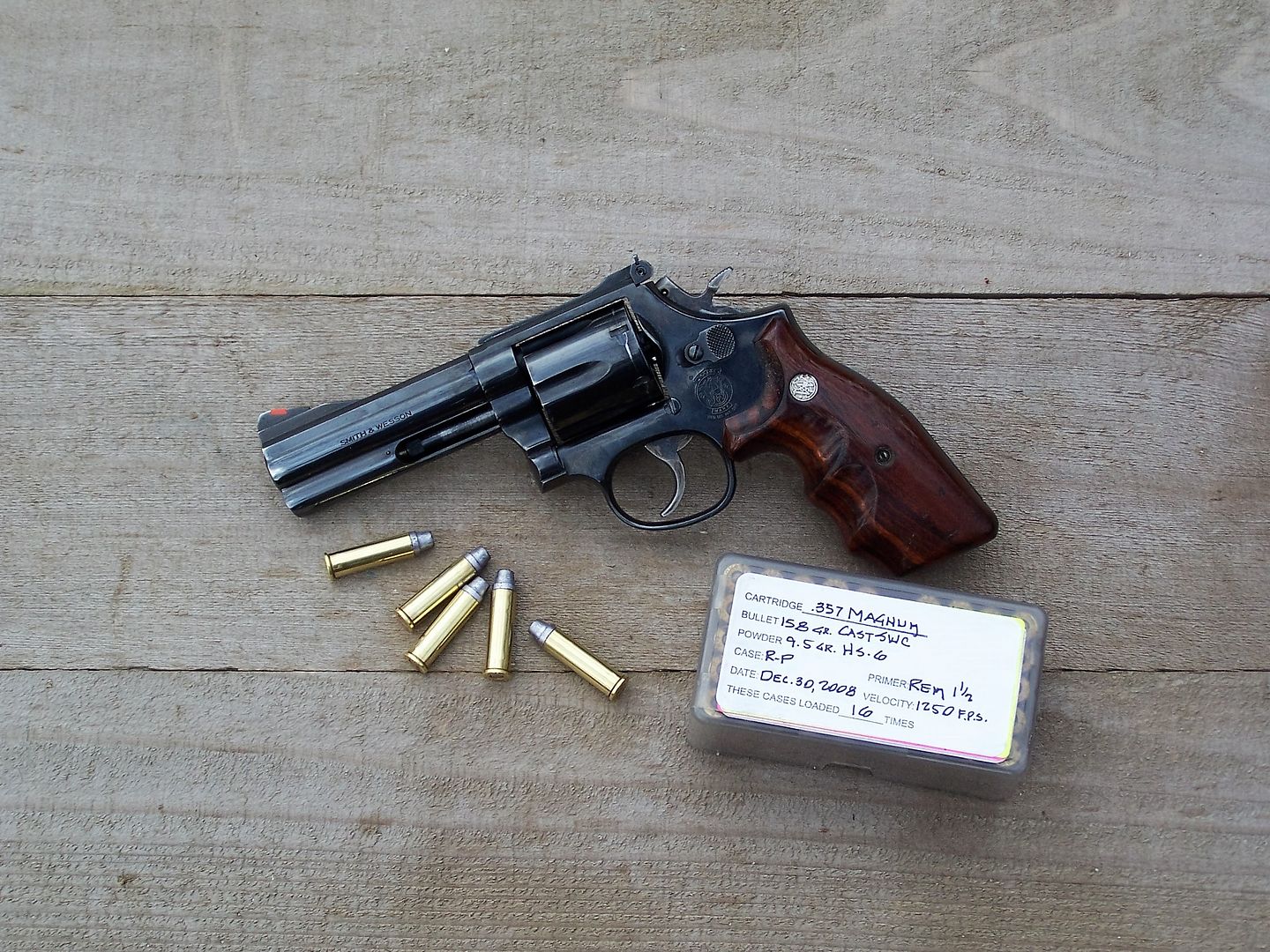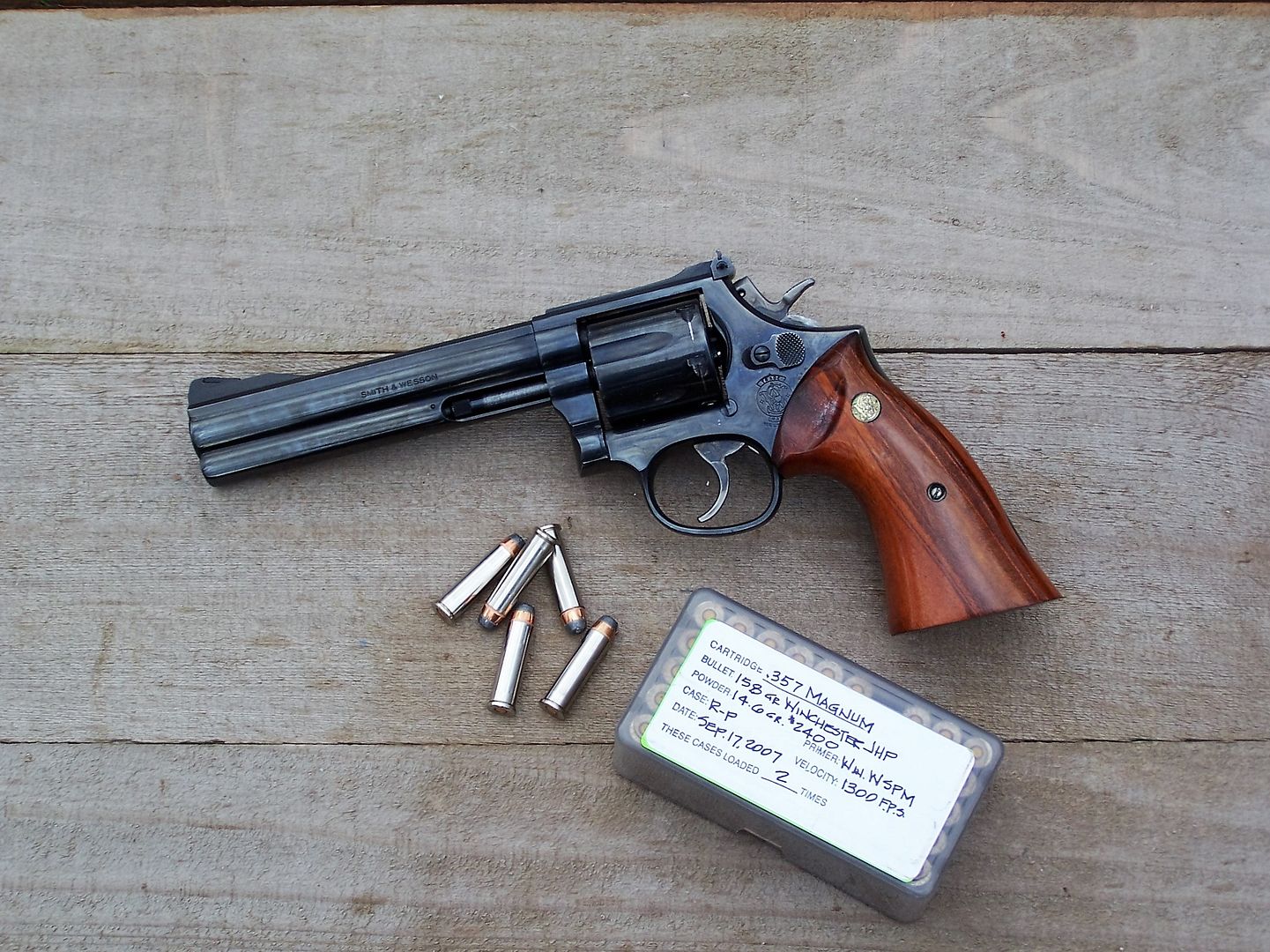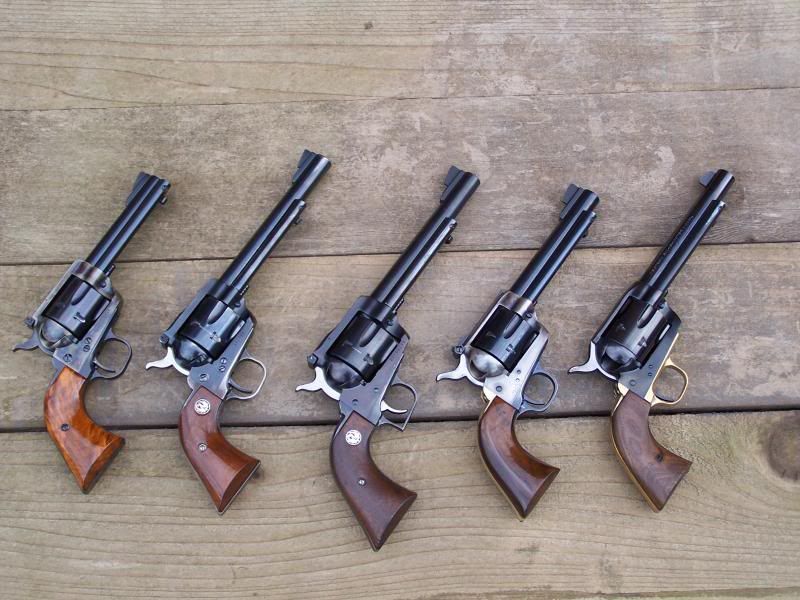You are using an out of date browser. It may not display this or other websites correctly.
You should upgrade or use an alternative browser.
You should upgrade or use an alternative browser.
Anyone shoot both 4" and 6" barreled .357 mag?
- Thread starter bricz75
- Start date
Onward Allusion
New member
I shoot both. Very little difference between 4" & 6" in terms of recoil. Flash & noise is a little more noticeable indoors that's about it.
VoodooMountain
New member
I've had a 6.5" Blackhawk
4" gp100
2.25" sp101
I know it isn't apples to apple with the Blackhawk being a sa.
Even the hottest loads were pleasant in the Blackhawk.
Gp100 has a loud bark and a little bite with warm loads
The sp101 was downright uncomfortable with most 357 loads and blinding with some 357 loads.
I don't think I would notice much of a difference between a 6" gp100 and my 4" example though. Most of my differences are from weight and grip design.
4" gp100
2.25" sp101
I know it isn't apples to apple with the Blackhawk being a sa.
Even the hottest loads were pleasant in the Blackhawk.
Gp100 has a loud bark and a little bite with warm loads
The sp101 was downright uncomfortable with most 357 loads and blinding with some 357 loads.
I don't think I would notice much of a difference between a 6" gp100 and my 4" example though. Most of my differences are from weight and grip design.
Last edited:
wild cat mccane
New member
I think the 6" is required for 357 performance.
If you don't care for that, the 4" is the way to go. While 6" doesn't feel bad, the 4" feels balanced.
If you don't care for that, the 4" is the way to go. While 6" doesn't feel bad, the 4" feels balanced.
Wheel-Gunner
New member
I own both and use both without giving too much thought, much easier that way.
You could also go for a 5", like my 686+. I also enjoy a 3".
The others I own that almost always just see range time are of the 7.5" and 8 3/8" variety.
With all that said, for your first a 4" is a good way to go.
You could also go for a 5", like my 686+. I also enjoy a 3".
The others I own that almost always just see range time are of the 7.5" and 8 3/8" variety.
With all that said, for your first a 4" is a good way to go.
Anyone shoot both 4" and 6" barreled .357 mag?
I own both. Recoil really depends on the gun and configuration. Barrel length is only a small factor in that.
The biggest difference is in velocity. Because of the ballistics of 357 you get a big step in velocity with most factory rounds when you move to a 6 inch barrel. I have chronoed many factory rounds side by side.
Sent from my iPhone using Tapatalk
I own both. Recoil really depends on the gun and configuration. Barrel length is only a small factor in that.
The biggest difference is in velocity. Because of the ballistics of 357 you get a big step in velocity with most factory rounds when you move to a 6 inch barrel. I have chronoed many factory rounds side by side.
Sent from my iPhone using Tapatalk
wild cat mccane
New member
Yes. Expect 9mm +P to be in with 4" 357 velocity.
I'm going to take the lightening. I think 9mm is better than 357 in a 4" barrel BECAUSE factory ammo in 9mm has more options loaded with better bullets (HST). You also do not get the large recoil from 9mm.
However, I own a 4" 357 because it is fun.
I'm going to take the lightening. I think 9mm is better than 357 in a 4" barrel BECAUSE factory ammo in 9mm has more options loaded with better bullets (HST). You also do not get the large recoil from 9mm.
However, I own a 4" 357 because it is fun.
Bob Wright
New member
Well, yes, I've shot both 4" and 6", plus a few other lengths:

And:

A couple of Model 19s:

And a few Single Actions:

The .357 Magnum is somewhat loud but for a low recoil, pleasant shooting round its superb as long as the range is kept fairly close, say fifty to seventy five yards. Makes a fine varmint combination.
Bob Wright

And:

A couple of Model 19s:

And a few Single Actions:

The .357 Magnum is somewhat loud but for a low recoil, pleasant shooting round its superb as long as the range is kept fairly close, say fifty to seventy five yards. Makes a fine varmint combination.
Bob Wright
I found myself wondering about the shooting experience of 6" barreled .357 mag revolvers. Using standard .357 mag ammo, how much less is recoil and muzzle flip from a 6" revolver compared to a 4" one (e.g. S&W L frame 6" vs. S&W L frame 4", or Ruger GP100 6" vs. GP100 4")?
The best thing for you to do is to get a set of what you are speaking about and learn straight from that on your own.
If we're speaking of two of the same revolver but with different barrel lengths, shooting the same ammo and load, then in general the longer (and heavier) gun will have less felt recoil, less muzzle rise, less flash and be a tad quieter then the shorter barreled gun. But this is "in general", based just on the guns and how you've outlined it (same guns different length barrels.).
If you had a 4" M19 and a 6" Python you'd find something else entirely.
Conduct the experiment on your own and for your benefit. You'll see that there's more to shooting different barrel lengths than what first meets the eye...and ears.
tipoc
^
Not true, check this Buffalo Bore round out.
They chronographed it through a 4in S&W and a 6in Python, the 4in was actually faster
https://www.midwayusa.com/product/1...num-158-grain-jacketed-hollow-point-box-of-20
Not true, check this Buffalo Bore round out.
They chronographed it through a 4in S&W and a 6in Python, the 4in was actually faster
https://www.midwayusa.com/product/1...num-158-grain-jacketed-hollow-point-box-of-20
This is a link to "Ballistics by the Inch" where you can see the actual velocity differences between various loads and bullets shot from various length barrels. This latter both from vented test barrels and also from guns.
http://www.ballisticsbytheinch.com/357mag.html
tipoc
http://www.ballisticsbytheinch.com/357mag.html
tipoc
Ballistics by the inch incorporates the C.O.A.L into the barrel length, so their numbers for the 4 and 6in "barells" are going to be essentially 1.59 inches shorter than a revolver in 357.
The actual gun data is more telling, not a huge velocity difference between 4 and 6in.
Certainly not 200fps
The actual gun data is more telling, not a huge velocity difference between 4 and 6in.
Certainly not 200fps
bamaranger
New member
used to
My first .357 revolvers were 6", but I traded them away for the more easy carrying 4" models.
I will say that I shot the 6" models, (a Dan Wesson 15-V, then a Model 27) very well, and milk jugs at 100 yds were in grave danger from the bench, or off sandbags prone. I nailed quite few groundhogs in the 50-75 yd range too usually from kneeling or seated. But as a GP pistol, I found a large frame 6" just too cumbersome to carry all day in a hip holster, and concealing one w/o a shoulder holster and down jacket seemed near impossible. I decided one could just about carry a tidy carbine as easily, and went and bought a Marlin so chambered.
My two .357's these days are a 4-5/8" B-hawk, and a 4" M28. I run the B-hawk with moderate lead SWC's, and the M28 gets full house 125gr mags. Both carry far easier than the 6" guns. I'm to the point that accuracy shooting with handguns is behind me, but before I passed 50 yrs, I shot the B-hawk nearly as well as the old Wesson or M27. I can't say I noticed any real difference in most loads in terms of blast or concussion, the exception being 125 gr full house stuff, which is pretty obnoxious in any revolver. I still have the Marlin too.
My first .357 revolvers were 6", but I traded them away for the more easy carrying 4" models.
I will say that I shot the 6" models, (a Dan Wesson 15-V, then a Model 27) very well, and milk jugs at 100 yds were in grave danger from the bench, or off sandbags prone. I nailed quite few groundhogs in the 50-75 yd range too usually from kneeling or seated. But as a GP pistol, I found a large frame 6" just too cumbersome to carry all day in a hip holster, and concealing one w/o a shoulder holster and down jacket seemed near impossible. I decided one could just about carry a tidy carbine as easily, and went and bought a Marlin so chambered.
My two .357's these days are a 4-5/8" B-hawk, and a 4" M28. I run the B-hawk with moderate lead SWC's, and the M28 gets full house 125gr mags. Both carry far easier than the 6" guns. I'm to the point that accuracy shooting with handguns is behind me, but before I passed 50 yrs, I shot the B-hawk nearly as well as the old Wesson or M27. I can't say I noticed any real difference in most loads in terms of blast or concussion, the exception being 125 gr full house stuff, which is pretty obnoxious in any revolver. I still have the Marlin too.
While velocity is important, concern over velocity difference is not something to lose any sleep over.
Ballistics by the inch, and everyone else's tests are interesting, and show general trends, but they are NOT an accurate predictor of what you will get with your guns and your ammo.
Your gun(s) and ammo might be very similar to the results they got. They MIGHT even be identical, but they also might be much different.
The ONLY way to know, for certain is to measure YOUR gun and YOUR ammo.
Everything else is just a guess.
I've seen 70-100fps difference in velocity between different gun with the same barrel length. I've seen a 4" turn in a few fps faster than an 8 inch.
Is this common? No. But it's not as rare as you might think.
Every gun and ammo combination is different, most fall close to the middle of the bell curve (naturally) and that's why the tests (and reloading data) are useful guidelines. But there is always the possibility that your gun & ammo might be at either end of the curve, where things are different.
Only testing what you have in your hands shows with certainty what it does, or doesn't do.
I've been loading and shooting .357s since the early 70s. S&W N frames, (4,6 & 8") Ruger DA and SA (6, 6.5") S&W K frames (4 & 6") and 6" & 10" Contenders and the 18" Marlin carbines. Also Desert Eagle and Coonan semi autos. I don't do .357 snub nose, No interest in them, for me .38 is enough in a snub nose,
The shorter barrel guns bounce more, and are louder (because the muzzle is closer to your ear). The bulk of a revolver is in the cylinder(frame) and grips. If you can "tuck" a 4" you can do a 6" about as well, usually.
Some people find the 4" points better for them, some find it depends on the specific model gun, more than the barrel length.
Ballistics by the inch, and everyone else's tests are interesting, and show general trends, but they are NOT an accurate predictor of what you will get with your guns and your ammo.
Your gun(s) and ammo might be very similar to the results they got. They MIGHT even be identical, but they also might be much different.
The ONLY way to know, for certain is to measure YOUR gun and YOUR ammo.
Everything else is just a guess.
I've seen 70-100fps difference in velocity between different gun with the same barrel length. I've seen a 4" turn in a few fps faster than an 8 inch.
Is this common? No. But it's not as rare as you might think.
Every gun and ammo combination is different, most fall close to the middle of the bell curve (naturally) and that's why the tests (and reloading data) are useful guidelines. But there is always the possibility that your gun & ammo might be at either end of the curve, where things are different.
Only testing what you have in your hands shows with certainty what it does, or doesn't do.
I've been loading and shooting .357s since the early 70s. S&W N frames, (4,6 & 8") Ruger DA and SA (6, 6.5") S&W K frames (4 & 6") and 6" & 10" Contenders and the 18" Marlin carbines. Also Desert Eagle and Coonan semi autos. I don't do .357 snub nose, No interest in them, for me .38 is enough in a snub nose,
The shorter barrel guns bounce more, and are louder (because the muzzle is closer to your ear). The bulk of a revolver is in the cylinder(frame) and grips. If you can "tuck" a 4" you can do a 6" about as well, usually.
Some people find the 4" points better for them, some find it depends on the specific model gun, more than the barrel length.
Mike Irwin
Staff
I have and shoot both 4 and 6" Model 19s and Model 28s.
To be honest, I've never noticed that much of a difference.
I do notice quite a bit of difference between the 19s and the 28s, though.
Things tend to get REALLY sporty when I touch off hot .357s in my 2.5" Model 19...
To be honest, I've never noticed that much of a difference.
I do notice quite a bit of difference between the 19s and the 28s, though.
Things tend to get REALLY sporty when I touch off hot .357s in my 2.5" Model 19...
